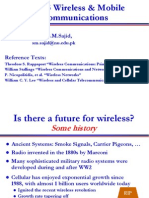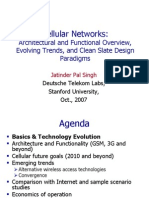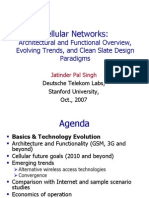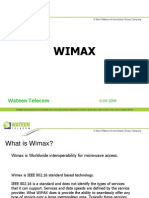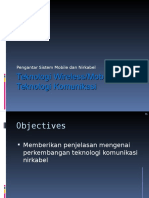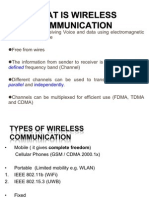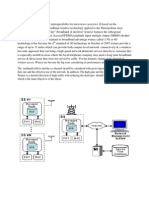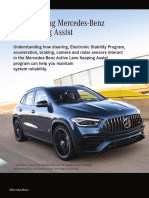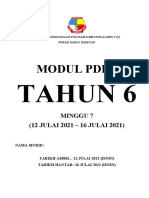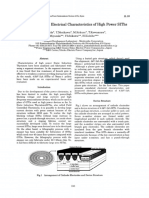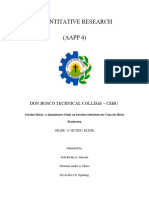0 ratings0% found this document useful (0 votes)
93 viewsSYSC4607: Wireless Communications Prof. Amir H. Banihashemi
SYSC4607: Wireless Communications Prof. Amir H. Banihashemi
Uploaded by
Abraham NdongThis document provides an outline for the SYSC4607: Wireless Communications course. It introduces the instructor and TAs, outlines the course topics including current and emerging wireless systems, and discusses some of the technical challenges in wireless communications like quality of service requirements across different applications and the need for cross-layer design approaches. The grading scheme and exam dates are also noted.
Copyright:
© All Rights Reserved
Available Formats
Download as PPT, PDF, TXT or read online from Scribd
SYSC4607: Wireless Communications Prof. Amir H. Banihashemi
SYSC4607: Wireless Communications Prof. Amir H. Banihashemi
Uploaded by
Abraham Ndong0 ratings0% found this document useful (0 votes)
93 views44 pagesThis document provides an outline for the SYSC4607: Wireless Communications course. It introduces the instructor and TAs, outlines the course topics including current and emerging wireless systems, and discusses some of the technical challenges in wireless communications like quality of service requirements across different applications and the need for cross-layer design approaches. The grading scheme and exam dates are also noted.
Original Title
Overview
Copyright
© © All Rights Reserved
Available Formats
PPT, PDF, TXT or read online from Scribd
Share this document
Did you find this document useful?
Is this content inappropriate?
This document provides an outline for the SYSC4607: Wireless Communications course. It introduces the instructor and TAs, outlines the course topics including current and emerging wireless systems, and discusses some of the technical challenges in wireless communications like quality of service requirements across different applications and the need for cross-layer design approaches. The grading scheme and exam dates are also noted.
Copyright:
© All Rights Reserved
Available Formats
Download as PPT, PDF, TXT or read online from Scribd
Download as ppt, pdf, or txt
0 ratings0% found this document useful (0 votes)
93 views44 pagesSYSC4607: Wireless Communications Prof. Amir H. Banihashemi
SYSC4607: Wireless Communications Prof. Amir H. Banihashemi
Uploaded by
Abraham NdongThis document provides an outline for the SYSC4607: Wireless Communications course. It introduces the instructor and TAs, outlines the course topics including current and emerging wireless systems, and discusses some of the technical challenges in wireless communications like quality of service requirements across different applications and the need for cross-layer design approaches. The grading scheme and exam dates are also noted.
Copyright:
© All Rights Reserved
Available Formats
Download as PPT, PDF, TXT or read online from Scribd
Download as ppt, pdf, or txt
You are on page 1of 44
SYSC4607: Wireless Communications
Prof. Amir H. Banihashemi
Outline
Course Information
Course Syllabus
The Wireless Vision
Technical Challenges
Current Wireless Systems
Emerging Wireless Systems
Spectrum Regulation
Standards
Course Information
Instructor: Amir H. Banihashemi,
ahashemi@sce.carleton.ca, MC7034, #8026,
Office hours: Wed. & Fri. 1:00-2:00 p.m.
TAs: Rostam Shirani (sh.rostam@gmail.com )
and Emil Janulewicz (ejanulewicz@gmail.com)
Course Information
Prerequisites: SYSC3501 or SYSC3503
Required Textbook: Wireless Communications by A.
Goldsmith, Cambridge University Press, 2005.
Available at bookstore or Amazon
Class Homepage:
http://www.sce.carleton.ca/courses/sysc-4607/w09/
Userid: sysc4607, Password:4607-w09
All handouts, announcements, assignments, etc. posted to website
Check the website regularly
Grading Scheme:
Assignments 16%, Labs 12%, Midterm 22%,
Final 50%
Assignments:
There will be eight graded assignments
Assignments and solutions will be posted on the
course webpage
Course Information
Course Information
Exams:
Midterm on Wednesday, Feb. 25 during the lecture time
Exams must be taken at scheduled time, no makeup exams
Exams cover all the material discussed during the lectures, in
the assignments, labs and tutorials
Tutorials:
Wednesday 8:30 - 11:30 a.m., 507 Architecture Building, even
weeks. First tutorial session is on Wednesday, Jan. 14.
Acknowledgement
The original slides used in this course are
created by Prof. Andrea Goldsmith,
Stanford University. They are modified by
Prof. Banihashemi according to the
content of this course.
Course Syllabus
Overview of Wireless Communications
Path Loss, Shadowing, and Fading Models
Capacity of Wireless Channels
Digital Modulation and its Performance
Adaptive Modulation
Diversity
MIMO Systems
Equalization, Multicarrier, and Spread Spectrum
Multiuser Communications
Wireless Networks
Wireless History
Radio invented in the 1880s by Marconi
Many sophisticated military radio systems were
developed during and after WW2
Cellular has enjoyed exponential growth since
1988, with almost 1 billion users worldwide today,
and ignited the recent wireless revolution
Ancient Systems: Smoke Signals, Carrier Pigeons,
Exciting Developments
Internet and laptop use exploding
2G/3G wireless LANs growing rapidly
Huge cell phone popularity worldwide
Emerging systems such as Bluetooth, Zigbee,
UWB, and WiMAX opening new doors
Military and security wireless needs
Important interdisciplinary applications
Future Wireless Networks
Wireless Internet access
Nth generation Cellular
Wireless Ad Hoc Networks
Sensor Networks
Wireless Entertainment
Smart Homes/Spaces
Automated Highways
All this and more
Ubiquitous Communication Among People and Devices
Hard Delay Constraints
Hard Energy Constraints
Design Challenges
Wireless channels are a difficult and capacity-
limited broadcast communications medium
Traffic patterns, user locations, and network
conditions are constantly changing
Applications are heterogeneous with hard
constraints that must be met by the network
Energy and delay constraints change design
principles across all layers of the protocol stack
Evolution of Current Systems
Wireless systems today
2G Cellular: ~30-70 Kbps.
WLANs: ~10 Mbps.
Next Generation
3G Cellular: ~300 Kbps.
WLANs: ~70 Mbps.
Technology Enhancements
Hardware: Better batteries, Better circuits/processors.
Link: Antennas, modulation, coding, adaptivity, DSP, BW.
Network: Dynamic resource allocation, Mobility support.
Application: Soft and adaptive QoS.
Future Generations
Rate
Mobility
2G
3G
4G
802.11b WLAN
2G Cellular
Other Tradeoffs:
Rate vs. Coverage
Rate vs. Delay
Rate vs. Cost
Rate vs. Energy
Fundamental Design Breakthroughs Needed
Multimedia Requirements
Voice Video Data
Delay
Packet Loss
BER
Data Rate
Traffic
<100ms - <100ms
<1% 0 <1%
10
-3
10
-6
10
-6
8-32 Kbps
1-100 Mbps
1-20 Mbps
Continuous
Bursty
Continuous
One-size-fits-all protocols and design do not work well
Wired networks use this approach, with poor results
Wireless Performance Gap
WIDE AREA CIRCUIT SWITCHING
User
Bit-Rate
(kbps)
14.4
digital
cellular
28.8 modem
ISDN
ATM
9.6 modem
2.4 modem
2.4 cellular
32 kbps
PCS
9.6 cellular
wired- wireless
bit-rate "gap"
1970 2000 1990 1980
YEAR
LOCAL AREA PACKET SWITCHING
User
Bit-Rate
(kbps)
Ethernet
FDDI
ATM
100 M
Ethernet
Polling
Packet
Radio
1st gen
WLAN
2nd gen
WLAN
wired- wireless
bit-rate "gap"
1970 2000 1990 1980
.01
.1
1
10
100
1000
10,000
100,000
YEAR
.01
.1
1
10
100
1000
10,000
100,000
Quality-of-Service (QoS)
QoS refers to the requirements associated with a
given application, typically rate and delay
requirements.
It is hard to make a one-size-fits all network that
supports requirements of different applications.
Wired networks often use this approach with
poor results, and they have much higher data
rates and better reliability than wireless.
QoS for all applications requires a cross-layer
design approach.
Crosslayer Design
Application
Network
Access
Link
Hardware
Delay Constraints
Rate Constraints
Energy Constraints
Adapt across design layers
Reduce uncertainty through scheduling
Provide robustness via diversity
Crosslayer Techniques
Adaptive techniques
Link, MAC, network, and application adaptation
Resource management and allocation (power control)
Diversity techniques
Link diversity (antennas, channels, etc.)
Access diversity
Route diversity
Application diversity
Content location/server diversity
Scheduling
Application scheduling/data prioritization
Resource reservation
Access scheduling
Current Wireless Systems
Cellular Systems
Wireless LANs
Satellite Systems
Paging Systems
Bluetooth
Ultrawideband radios
Zigbee radios
Cellular Systems:
Reuse channels to maximize capacity
Geographic region divided into cells
Frequencies/timeslots/codes reused at spatially-separated locations.
Co-channel interference between same color cells.
Base stations/MTSOs coordinate handoff and control functions
Shrinking cell size increases capacity, as well as networking burden
BASE
STATION
MTSO
Cellular Phone Networks
BS
BS
MTSO
PSTN
MTSO
BS
San Francisco
New York
Internet
3G Cellular Design:
Voice and Data
Data is bursty, whereas voice is continuous
Typically require different access and routing strategies
3G widens the data pipe:
384 Kbps.
Standard based on wideband CDMA
Packet-based switching for both voice and data
3G cellular struggling in Europe and Asia
Evolution of existing systems (2.5G,2.6798G):
GSM+EDGE
IS-95(CDMA)+HDR
100 Kbps may be enough
What is beyond 3G?
The trillion dollar question
Wireless Local Area
Networks (WLANs)
WLANs connect local computers (100m range)
Breaks data into packets
Channel access is shared (random access)
Backbone Internet provides best-effort service
Poor performance in some apps (e.g. video)
01011011
Internet
Access
Point
0101
1011
Wireless LAN Standards
802.11b (Current Generation)
Standard for 2.4GHz ISM band (80 MHz)
Frequency hopped spread spectrum
1.6-10 Mbps, 500 ft range
802.11a (Emerging Generation)
Standard for 5GHz NII band (300 MHz)
OFDM with time division
20-70 Mbps, variable range
Similar to HiperLAN in Europe
802.11g (New Standard)
Standard in 2.4 GHz and 5 GHz bands
OFDM
Speeds up to 54 Mbps
Many WLAN
cards support
all 3
standards
Satellite Systems
Cover very large areas
Different orbit heights
GEOs (39000 Km) versus LEOs (2000 Km)
Optimized for one-way transmission
Radio and movie broadcasting
Most two-way systems struggling or bankrupt
Expensive alternative to terrestrial system
A few ambitious systems on the horizon
Paging Systems
Broad coverage for short messaging
Message broadcast from all base stations
Simple terminals
Optimized for 1-way transmission
Answer-back hard
Overtaken by cellular
8C32810.61-Cimini-7/98
Bluetooth
Cable replacement RF technology (low cost)
Short range (10m, extendable to 100m)
2.4 GHz band (crowded)
1 Data (700 Kbps) and 3 voice channels
Widely supported by telecommunications,
PC, and consumer electronics companies
Ultrawideband Radio (UWB)
UWB is an impulse radio: sends pulses of tens of
picoseconds(10
-12
) to nanoseconds (10
-9
)
Duty cycle of only a fraction of a percent
A carrier is not necessarily needed
Uses a lot of bandwidth (GHz)
Low probability of detection
Excellent ranging capability
Multipath highly resolvable
Can use OFDM to get around multipath problem.
Why is UWB Interesting?
Unique Location and Positioning properties
1 cm accuracy possible
Low Power CMOS transmitters
100 times lower than Bluetooth for same range/data rate
Very high data rates possible
500 Mbps at 10 feet under current regulations
7.5 Ghz of free spectrum in the U.S.
FCC recently legalized UWB for commercial use
Spectrum allocation overlays existing users, but its allowed
power level is very low to minimize interference (underlay
system)
Data rate scales with the shorter pulse widths made
possible with ever faster CMOS circuits
IEEE 802.15.4 / ZigBee Radios
Low-Rate WPAN
Data rates of 20, 40, 250 kbps
Star clusters or peer-to-peer operation
Support for low latency devices
CSMA channel access
Very low power consumption (Sensor networks,
Inventory tags)
Frequency of operation in ISM bands
Focus is primarily on radio and access techniques
Data rate
10 kbits/sec
100 kbits/sec
1 Mbit/sec
10 Mbit/sec
100 Mbit/sec
0 GHz 2 GHz 1GHz 3 GHz 5 GHz 4 GHz 6 GHz
802.11a
UWB
ZigBee
Bluetooth
ZigBee
802.11b
802.11g
3G
UWB
Range
1 m
10 m
100 m
1 km
10 km
0 GHz 2 GHz 1GHz 3 GHz 5 GHz 4 GHz 6 GHz
802.11a
UWB
ZigBee
Bluetooth
ZigBee
802.11b,g
3G
UWB
Power Dissipation
1 mW
10 mW
100 mW
1 W
10 W
0 GHz 2 GHz 1GHz 3 GHz 5 GHz 4 GHz 6 GHz
802.11a
UWB
UWB
ZigBee
Bluetooth
ZigBee
802.11bg 3G
Emerging Systems
Ad hoc wireless networks
Sensor networks
Distributed control networks
Ad-Hoc Networks
Peer-to-peer communications.
No backbone infrastructure.
Routing can be multihop.
Topology is dynamic.
Fully connected with different link SINRs
Design Issues
Ad-hoc networks provide a flexible network
infrastructure for many emerging applications.
The capacity of such networks is generally
unknown.
Transmission, access, and routing strategies for
ad-hoc networks are generally ad-hoc.
Crosslayer design critical and very challenging.
Energy constraints impose interesting design
tradeoffs for communication and networking.
Sensor Networks
Energy is the driving constraint
Nodes powered by nonrechargeable batteries
Data flows to centralized location.
Low per-node rates but up to 100,000 nodes.
Data highly correlated in time and space.
Nodes can cooperate in transmission, reception,
compression, and signal processing.
Energy-Constrained Nodes
Each node can only send a finite number of bits.
Transmit energy minimized by maximizing bit time
Circuit energy consumption increases with bit time
Introduces a delay versus energy tradeoff for each bit
Short-range networks must consider transmit,
circuit, and processing energy.
Sophisticated techniques not necessarily energy-efficient.
Sleep modes save energy but complicate networking.
Changes everything about the network design:
Bit allocation must be optimized across all protocols.
Delay vs. throughput vs. node/network lifetime tradeoffs.
Optimization of node cooperation.
Distributed Control over
Wireless Links
Packet loss and/or delays impacts controller performance.
Controller design should be robust to network faults.
Joint application and communication network design.
Automated Vehicles
- Cars
- UAVs
Joint Design Challenges
There is no methodology to incorporate random
delays or packet losses into control system designs.
The best rate/delay tradeoff for a communication
system in distributed control cannot be determined.
Current autonomous vehicle platoon controllers are
not string stable with any communication delay
Can we make distributed control robust to the network?
Yes, by a radical redesign of the controller and the network.
Spectrum Regulation
Spectral Allocation in Canada is managed by Industry
Canada in close collaboration with users and industries
Industry Canada auctions spectral blocks for specific
applications.
Some spectrum set aside for unlicensed use
Canada is a key player in the ITU-R and contributes
heavily to bilateral and multilateral cooperation with
respect to the use of radio frequencies.
Standards
Interacting systems require standardization
Companies want their systems adopted as standard
Standards determined by TIA/CTIA in US
IEEE standards often adopted
Process fraught with inefficiencies and conflicts
Worldwide standards determined by ITU-T
In Europe, ETSI is equivalent of IEEE
Standards for current systems are summarized in Appendix D.
Main Points
The wireless vision encompasses many exciting systems
and applications
Technical challenges transcend across all layers of the
system design.
Cross-layer design emerging as a key theme in wireless.
Existing and emerging systems provide excellent quality
for certain applications but poor interoperability.
Standards and spectral allocation heavily impact the
evolution of wireless technology
You might also like
- StopWatch ReportDocument11 pagesStopWatch ReportGeoffrey Chua0% (1)
- Guide To PrescribingDocument68 pagesGuide To PrescribingPetrea Cosmin50% (2)
- Wireless TutorialDocument98 pagesWireless TutorialCésar Eduardo Cofré ReyesNo ratings yet
- Wireless and Mobile Communications: Dr. T. ShankarDocument43 pagesWireless and Mobile Communications: Dr. T. Shankarmonu bNo ratings yet
- Wireless Networks Seminar Report and TopicDocument32 pagesWireless Networks Seminar Report and TopicAnkit KumarNo ratings yet
- Instructor: Dr. S.M.Sajid,: SM - Sajid@nu - Edu.pkDocument29 pagesInstructor: Dr. S.M.Sajid,: SM - Sajid@nu - Edu.pkkami2121No ratings yet
- Wireless and Mobile Communications: Dr. Surbhi SharmaDocument42 pagesWireless and Mobile Communications: Dr. Surbhi SharmaShubham MittalNo ratings yet
- Recent TrendsDocument28 pagesRecent Trendsashokyadav739No ratings yet
- EE 359: Wireless Communications: Professor Andrea GoldsmithDocument46 pagesEE 359: Wireless Communications: Professor Andrea Goldsmithsmile0lifeNo ratings yet
- An Overview of Wireless Communication Systems-II Communication Systems-IIDocument28 pagesAn Overview of Wireless Communication Systems-II Communication Systems-IISeelam KomalkumarNo ratings yet
- Lecture 1Document48 pagesLecture 1kruthika86No ratings yet
- Outline: EE 359: Wireless CommunicationsDocument9 pagesOutline: EE 359: Wireless CommunicationsDnyaneshwar AhirraoNo ratings yet
- Intro LectureDocument47 pagesIntro LecturekrishpriNo ratings yet
- Cellular Networks:: Architectural and Functional Overview, Evolving Trends, and Clean Slate Design ParadigmsDocument33 pagesCellular Networks:: Architectural and Functional Overview, Evolving Trends, and Clean Slate Design ParadigmsMohit SinghaiNo ratings yet
- Lecture 1-2 Introduction To Wiress CommunicationsDocument49 pagesLecture 1-2 Introduction To Wiress CommunicationsSyed RazaNo ratings yet
- Cleans Late Stanford SinghDocument33 pagesCleans Late Stanford SinghVikasAminNo ratings yet
- Advanced Wireless CommunicationsDocument39 pagesAdvanced Wireless CommunicationsRaees AhmadNo ratings yet
- Outline: EE 179: Introduction To CommunicationsDocument8 pagesOutline: EE 179: Introduction To CommunicationsThủy Hoàng MinhNo ratings yet
- Lecture Notes 2Document39 pagesLecture Notes 2Yakout FetNo ratings yet
- Introduction To Cellular Networking and Rethinking Mobile ArchitecturesDocument31 pagesIntroduction To Cellular Networking and Rethinking Mobile ArchitecturesJen N. de ChavezNo ratings yet
- Clean Slate Stanford SinghDocument33 pagesClean Slate Stanford SinghMayank SardanaNo ratings yet
- 2009 New Presentation On WimaxDocument68 pages2009 New Presentation On WimaxHarazneh Abu HazemNo ratings yet
- Applications of MIMODocument2 pagesApplications of MIMOPriyadarshini GoreNo ratings yet
- Click To Enter Your TitleDocument30 pagesClick To Enter Your TitleVani KrNo ratings yet
- Wireless Comm PPts SheetsDocument203 pagesWireless Comm PPts SheetsBADSHAH TECHNo ratings yet
- Deploying High Capacity Wi-Fi Networks: John DigiovanniDocument25 pagesDeploying High Capacity Wi-Fi Networks: John DigiovannisurajbhanuNo ratings yet
- Benefits of Eband Over Other Technologies White Paper V051310Document10 pagesBenefits of Eband Over Other Technologies White Paper V051310rakeshksaraf-1No ratings yet
- Wireless Broadband With Wimax: Hype and Reality: Dr. Jeffrey G. AndrewsDocument25 pagesWireless Broadband With Wimax: Hype and Reality: Dr. Jeffrey G. AndrewsKarthik SharmaNo ratings yet
- Wireless and Mobile ComputingDocument520 pagesWireless and Mobile ComputingFembiRekrisnaGrandeaPutraNo ratings yet
- Introduction To Cellular Networking and Rethinking Mobile ArchitecturesDocument31 pagesIntroduction To Cellular Networking and Rethinking Mobile ArchitecturesVikas KNo ratings yet
- Lesson - Chapter 1 - 2 IntroductionDocument20 pagesLesson - Chapter 1 - 2 IntroductionTuấn Đạt Lê XuânNo ratings yet
- WMC FullDocument208 pagesWMC FullAbhay KumarNo ratings yet
- 6-3emerging Network TechnologiesDocument24 pages6-3emerging Network TechnologiesBijay PoudelNo ratings yet
- Teknologi Wireless/Mobile: Teknologi KomunikasiDocument55 pagesTeknologi Wireless/Mobile: Teknologi KomunikasiUdjo MokoNo ratings yet
- Teknologi Jaringan WiMAXDocument48 pagesTeknologi Jaringan WiMAXIkhwani Fill IlmiNo ratings yet
- Wireless and Mobile Communication Systems: Chapter OneDocument46 pagesWireless and Mobile Communication Systems: Chapter OneMedan TamerateNo ratings yet
- Wimax WifiDocument23 pagesWimax WifiAli SahalNo ratings yet
- Unit 1Document32 pagesUnit 1tanishachaturvedi2025No ratings yet
- Teknologi Jaringan WiMAXDocument26 pagesTeknologi Jaringan WiMAXnanang_tciNo ratings yet
- Local Multipoint Distribution Service (LMDS)Document21 pagesLocal Multipoint Distribution Service (LMDS)Bibin PuthiyathNo ratings yet
- WLANDocument26 pagesWLANAftab PopatiaNo ratings yet
- Wimax Reality: Peter HendrickDocument15 pagesWimax Reality: Peter HendrickAbel RoblesNo ratings yet
- What Is Wireless CommunicationDocument43 pagesWhat Is Wireless CommunicationRachitaRasiwasia100% (1)
- 4G Wireless TerminalsDocument8 pages4G Wireless TerminalsbachirtalebalifaceNo ratings yet
- Wireless LAN Technology: Chapter 10 (Pahlavan)Document45 pagesWireless LAN Technology: Chapter 10 (Pahlavan)Suman MarthaNo ratings yet
- Cordless Systems and Wireless Local LoopDocument36 pagesCordless Systems and Wireless Local LoopJashanpreet SinghNo ratings yet
- Blutooth Vs WlanDocument24 pagesBlutooth Vs WlaniabhinavmishraNo ratings yet
- Presentation ON 4G-Technology: Presented By: Sonia Choudhary B. E. Ivth Year I.T GvsetDocument25 pagesPresentation ON 4G-Technology: Presented By: Sonia Choudhary B. E. Ivth Year I.T GvsetShahbaz AlamNo ratings yet
- 2g 3g WLL Cellular ConceptDocument39 pages2g 3g WLL Cellular ConceptVinod KumbharNo ratings yet
- Wireless Communication: Dr. B.Rebekka Assistant Professor Dept. of ECE, NIT, TrichyDocument86 pagesWireless Communication: Dr. B.Rebekka Assistant Professor Dept. of ECE, NIT, TrichyRithanathithNo ratings yet
- A Paper Presentation On: The Dawn of New Technical EraDocument17 pagesA Paper Presentation On: The Dawn of New Technical Erajyothsnas28No ratings yet
- Back HaulDocument38 pagesBack HaulcprathiNo ratings yet
- A. Lecture - Introduction Optical Fiber Communication.Document57 pagesA. Lecture - Introduction Optical Fiber Communication.gauravnitin123No ratings yet
- 802.16d Fixed Broadband Radio Access Standard: It Specifies The Air Interface LayerDocument6 pages802.16d Fixed Broadband Radio Access Standard: It Specifies The Air Interface LayerTafiqur RahmanNo ratings yet
- Lec 1 - Introduction To Wireless CommunicationDocument59 pagesLec 1 - Introduction To Wireless CommunicationRashidKhanNo ratings yet
- Presentation ON 4G-Technology: Presented By: Sonia Choudhary B. E. Ivth Year I.T GvsetDocument25 pagesPresentation ON 4G-Technology: Presented By: Sonia Choudhary B. E. Ivth Year I.T Gvsetaskiran1237807No ratings yet
- hw1S06 SolDocument5 pageshw1S06 SolSumeet ten DoeschateNo ratings yet
- Modeling and Dimensioning of Mobile Wireless Networks: From GSM to LTEFrom EverandModeling and Dimensioning of Mobile Wireless Networks: From GSM to LTENo ratings yet
- Sereer DictionaryDocument68 pagesSereer DictionaryAbraham NdongNo ratings yet
- Umts PSC PlanningDocument18 pagesUmts PSC PlanningAbraham NdongNo ratings yet
- 742225Document2 pages742225Јовица БлагојескиNo ratings yet
- Accessibility AnalysisDocument2 pagesAccessibility AnalysisAbraham NdongNo ratings yet
- Accessibility AnalysisDocument2 pagesAccessibility AnalysisAbraham NdongNo ratings yet
- Drive Test With TEMSDocument5 pagesDrive Test With TEMSAbraham NdongNo ratings yet
- KpiDocument89 pagesKpiAbraham NdongNo ratings yet
- TEMS Discovery 4.0.11 Release Note PDFDocument7 pagesTEMS Discovery 4.0.11 Release Note PDFAbraham NdongNo ratings yet
- SGSNDocument21 pagesSGSNAbraham NdongNo ratings yet
- WpaDocument39 pagesWpaAbraham NdongNo ratings yet
- RF Planning and Optimization PDFDocument44 pagesRF Planning and Optimization PDFAbraham Ndong83% (6)
- Eco TrainingDocument37 pagesEco TrainingLito TanNo ratings yet
- Gabarito Ciclo 06 Prova 01Document52 pagesGabarito Ciclo 06 Prova 01cibeleNo ratings yet
- User Mannual For Esp 12e Motor Shield PDFDocument11 pagesUser Mannual For Esp 12e Motor Shield PDFMit Upadhyay100% (1)
- Complete List of Attempted Jewish ExpulsionsDocument44 pagesComplete List of Attempted Jewish ExpulsionsNiels PeterNo ratings yet
- Aloha Lecture Notes: FaadooengineersDocument3 pagesAloha Lecture Notes: Faadooengineerstooba mukhtarNo ratings yet
- Module 4: Transportation Problem and Assignment Problem: Prasad A Y, Dept of CSE, ACSCE, B'lore-74Document37 pagesModule 4: Transportation Problem and Assignment Problem: Prasad A Y, Dept of CSE, ACSCE, B'lore-74Hào Văn TríNo ratings yet
- Take Home Quiz 2Document2 pagesTake Home Quiz 2Anonymous 2PJYuRhG0qNo ratings yet
- Estrada V Office of The OmbudsmanDocument12 pagesEstrada V Office of The OmbudsmanShanicaNo ratings yet
- Graylands Hospital Drug Bulletin: Medications and Electroconvulsive TherapyDocument9 pagesGraylands Hospital Drug Bulletin: Medications and Electroconvulsive TherapyRoshita G PillaiNo ratings yet
- Understanding Mercedes Benz Lane Keeping AssistDocument6 pagesUnderstanding Mercedes Benz Lane Keeping Assistmichelle D' AlbaNo ratings yet
- QUESTION - BANK - 50 QuestionsDocument7 pagesQUESTION - BANK - 50 QuestionsTsegaye Debelo100% (1)
- Year 6 Week 7Document20 pagesYear 6 Week 7suhashini selva rajNo ratings yet
- Eee163 P2Document41 pagesEee163 P2itzhishamhereNo ratings yet
- Bai Tap Ren Luyen Ky Nang 3 - Hoàng M AnDocument7 pagesBai Tap Ren Luyen Ky Nang 3 - Hoàng M AnAn Hoang MyNo ratings yet
- Case Study of An Indigenous Brand - Parle-G: Harish K. RamanDocument15 pagesCase Study of An Indigenous Brand - Parle-G: Harish K. RamanAsheeshMahajanNo ratings yet
- Marks Four Myth Human RightsDocument18 pagesMarks Four Myth Human RightsErnesto Cabrera GarcíaNo ratings yet
- ConToolbox Cable GlandsDocument1 pageConToolbox Cable GlandstongaiNo ratings yet
- What Is An Article and How Do You Write One For The B2 First?Document5 pagesWhat Is An Article and How Do You Write One For The B2 First?PatyNo ratings yet
- Consideration On Electrical Characteristics of High Power SithsDocument4 pagesConsideration On Electrical Characteristics of High Power Sithsdino saurNo ratings yet
- Password Based Door LockingDocument1 pagePassword Based Door Lockingdannycbs100% (1)
- 182 (530 - 550) ASTRO 5 Semi - CHSM72M-HCDocument2 pages182 (530 - 550) ASTRO 5 Semi - CHSM72M-HCIancu LaureanNo ratings yet
- Practical Research 2 Group 1Document22 pagesPractical Research 2 Group 1Luis ConcepcionNo ratings yet
- Arch Expansion and LengtheningDocument105 pagesArch Expansion and Lengtheningpriyanka chaudharyNo ratings yet
- Sawdust Brick A Quantitative Study On Sawdust Substitute For Concrete Brick ProductionDocument21 pagesSawdust Brick A Quantitative Study On Sawdust Substitute For Concrete Brick ProductionChristian Andre FloresNo ratings yet
- Systems Integration ArchitectureDocument22 pagesSystems Integration ArchitectureAlina Aire MacatangayNo ratings yet
- Raymond Hickey - Contrastive Linguistics (Introduction)Document33 pagesRaymond Hickey - Contrastive Linguistics (Introduction)Branislava DilparićNo ratings yet
- RHW User ManualDocument130 pagesRHW User Manualeugenio02No ratings yet
- Module 1 The-Contemporary-WorldDocument9 pagesModule 1 The-Contemporary-WorldRáche SolonNo ratings yet






